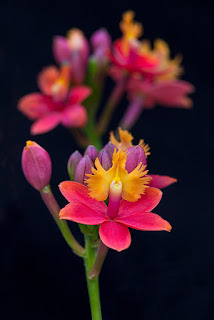As a nature
photographer, Anne Belmont's greatest passion is photographing the beauty of
the Chicago Botanic Garden. On any given day you will find her there capturing
the garden scenes, the flowers, plants and butterflies that comprise the
Chicago Botanic Garden's 385 acres. Anne's greatest interest lies in seeing and
photographing the world up-close, appreciating the beauty in the small, often
unnoticed details. Flowers are her favorite macro subject. Her commitment lies in sharing the beauty of
nature with others in hopes of fostering a deeper appreciation of nature and a
desire to protect the natural world.
Who
doesn't love flowers? They are beautiful
subjects for everyone from the amateur to the professional photographer, full
of color, texture, patterns and personality, and they are readily available
year-round. During my presentation for
the CAPS Conference, “Macro Flower Photography: The Art of Seeing and Capturing
the Beauty of Flowers,” I will cover everything you need to know to create
beautiful flower portraits, from what equipment is necessary, light,
composition, depth of field, the importance of background and even share a few
tips for post processing flowers. One of the subjects I am passionate about
sharing with others is developing the “art of seeing.”
One
of the most important factors in finding interesting subjects with emotional
impact is learning to see. Sounds simple, right? Actually, no. I believe it is
something that takes time and patience to develop. Learning to see means
slowing down, taking your time to stop and deliberately look at your subjects,
whether they are flowers, plant life, architecture or landscapes. Some
photographers have coined it Contemplative Photography. It describes an
approach to photography in which you combine the practice of seeing with
mindfulness. It is about being in the here and now, being present in the
moment. A little too “new age” for you?
Think of it as “being in the zone.” It requires one to slow down. Don’t
just glance at surroundings but, rather, closely observe, pay attention to
details. I find that just being in nature puts me in this “zone.” Immediately
when I step in a natural place, I can feel the distractions of the day exit; my
mind clears, I breathe deeply and I immerse myself in my surroundings. It is a
feeling I could identify in my childhood. I know this approach helps me to
“see” better and, thus, get better photographs. This mindfulness in photography
can be applied to any genre of photography, but I know that my fondness for
macro photography grows out of a life-long love of seeing the details in
nature, looking at the world up close. I
always spend a good deal of time looking and studying flowers before deciding a
subject to photograph. Train your eye to notice details, look for interesting
lines, sensuous curves. I often say to others that I am looking for flowers
with personality. They have a certain attitude, a curl to the petal, stem or
leaf, a beautiful pattern. Something catches my eye that I know will translate
into an interesting photograph with a story. Learn to see abstractly, as well.
Look beyond the literal qualities of your subject to the more abstract
qualities of line, form, mood, shape, color, patterns and texture. Studying my
subject in such a way helps me know how I want to shoot it, what aperture I
want to use and what part of the flower I want to emphasize. Most importantly,
look for the beautiful light, a subject I will go into great depth in my
presentation. We all know that light is
one of the most essential elements to creating impactful photographs in all
types of photography, and flower photography is no different. Good flower
portraits require a good understanding of light, an ability to recognize it and
how to manipulate it.
I
started my love of photography in the film era. Although I would never turn
back I think one thing that is important to bring with us to the digital age
from this era is that purposefulness, that slowing down to compose correctly.
Back in the film days, out of a need to get the most out of a roll of film, we
had to think more carefully about what we were shooting. We had no post
processing, so we had to get it right in camera. In the digital age, we can
fire away, 100’s if not 1000's of images in a shoot. Digital is seductive in
that way. I find, however, when I slow down and more purposefully look and
compose I may go home with fewer images but I am happier with my results and
have more keepers. It doesn’t mean that I don’t still go home with 100’s of
images. It doesn’t hurt that my playground, The Chicago Botanic Garden, has
endless subjects to shoot. I look forward to sharing my work and passion for
flowers and macro photography with you in November at CAPS-Chicago Area Photographic School.









